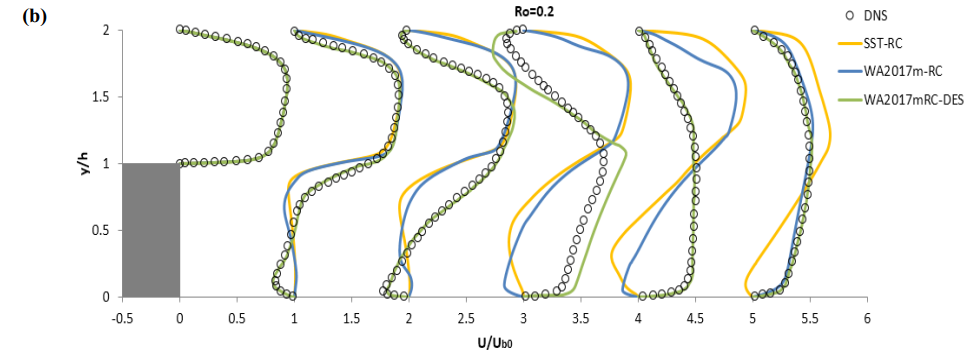SRF求解器的使用
-
看这个描述。如果是yes,那你的Urel就是你给的值,如果是yes,那你就给出绝对速度,然后Urel会进行一定的计算后得出真实值。
你的应该是No
Description Velocity condition to be used in conjunction with the single rotating frame (SRF) model (see: SRFModel class) Given the free stream velocity in the absolute frame, the condition applies the appropriate rotation transformation in time and space to determine the local velocity. The optional \c relative flag switches the behaviour of the patch such that: - relative = yes: inlet velocity applied 'as is': \f[ U_p = U_{in} \f] - relative = no : SRF velocity is subtracted from the inlet velocity: \f[ U_p = U_{in} - U_{p,srf} \f] where \vartable U_p = patch velocity [m/s] U_{in} = user-specified inlet velocity U_{p,srf} = SRF velocity \endvartable \heading Patch usage \table Property | Description | Required | Default value inletValue | inlet velocity | yes | relative | inletValue relative motion to the SRF? | yes | \endtable Example of the boundary condition specification: \verbatim myPatch { type SRFVelocity; inletValue uniform (0 0 0); relative yes; value uniform (0 0 0); // initial value } \endverbatim -
一年多了还是没有解决这个算例,不知道有没有人做过相类似的,重新描述下这个算例,如图所示一个后台阶流动,但是是在图中左下(0,0,0)位置为原点绕Z轴旋转,主要流动参数,
雷诺数$Re_b=\frac{U_b(H-h)}{\nu}=5600$,其中$U_b$是体积平均速度;
旋转数$U_b=\frac{\Omega(H-h)}{U_b}$,$\Omega$是角速度;
台阶前段槽道流部分壁面剪切雷诺数$Re_\tau=\frac{u_\tau(H-h)}{\nu}=360$,这个与槽道流DNS结果是完全一致的,也就是说台阶前是完全发展的槽道流。目前存在以下问题:
1、求解器选择,SRF类还是需要自己修改求解器?
2、合理的进口条件,不旋转的相对好给,但是旋转的case,速度进口边界条件和初始值不知道如何给合理。
3、无量纲化的流向速度为什么会小于1,如下图所示。以我的经验,槽道流里面最大速度比体积平均速度肯定是大的,也就是$\frac{U_{max}}{U_b}$是大于1的,但是为什么在旋转流动里面就会于1呢?

参考文献
1、DNS原始文献:Turbulent flow over a backward-facing step. Part 1. Effects of anti-cyclonic system rotation
2、图片来自:Development and Application of Rotation and Curvature Correction,是篇博士论文

